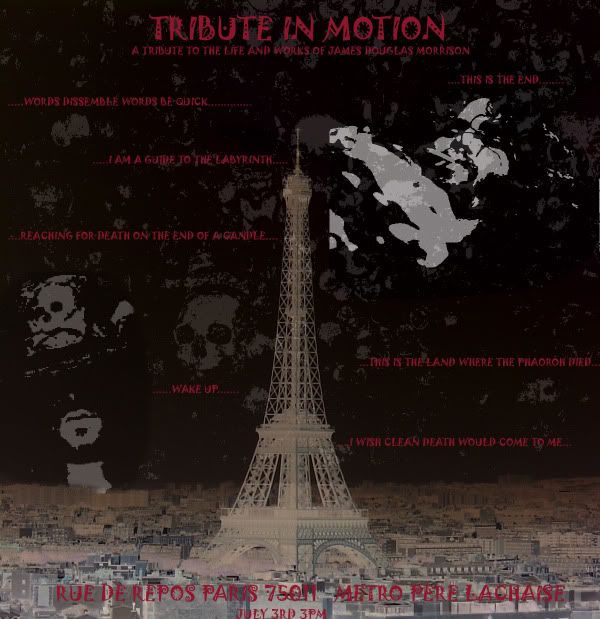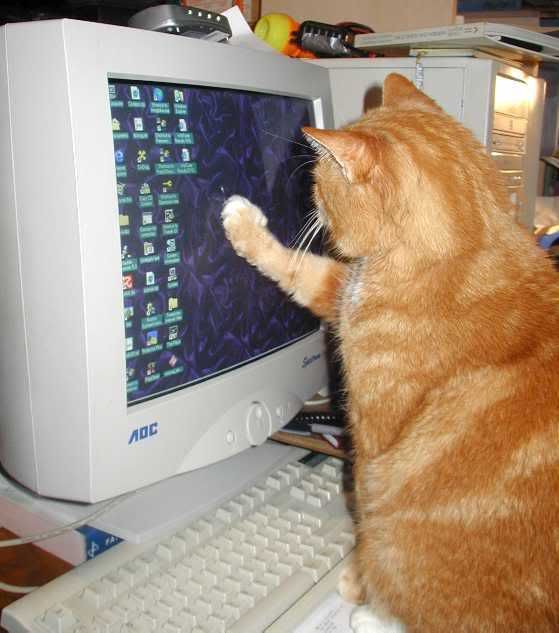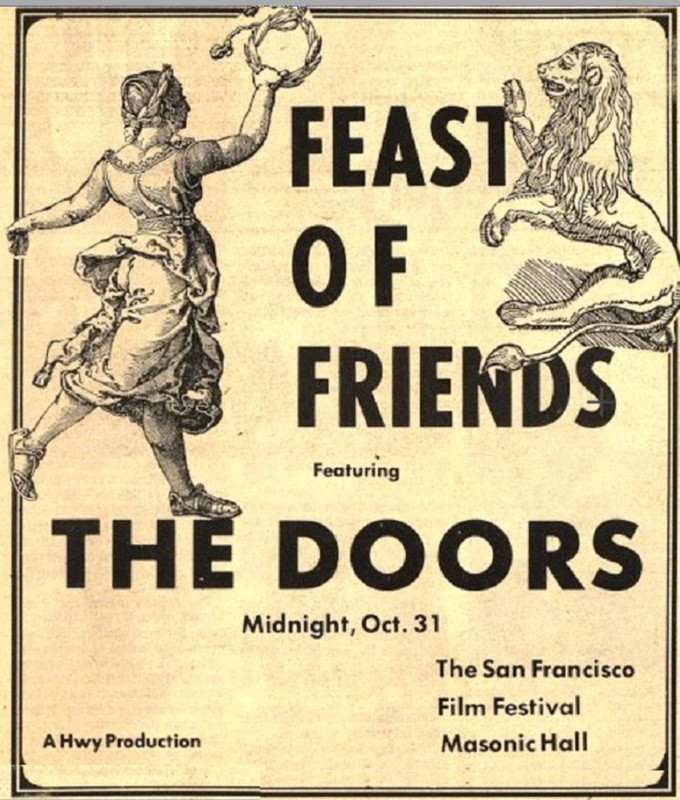Post by thebadcowboy on May 5, 2006 14:50:10 GMT
MEASURED MOVEMENTS with HANK ZEVALLOS
JIM MORRISON FILM FESTIVAL

Remembering The Once Only,
You-Had-To-Have-Been-There,
Jim Morrison Film Festival
There's a book wrapped around this story.
So clearly the task here is to stick to the event.
This is a true story.
I met The Doors when they were still a local L.A. band, and I instantly took to their music, becoming one of the first persons to write about them. "Strange Days" was the first recording session I ever attended, and that was prior to my photographer and I turning on local college DJs to "Light My Fire" with its extended instrumental from two boxes of 25 each copies of their great debut LP, which we had been given. Requests for that song soon led Top 40 KHJ radio to ask Elektra for a single-length version of it.
Because I soon found what I had been doing for fun was being taken seriously and quoted, I decided to take a vacation to England, check out the scene there and "clear my head" with new perspectives.
However, another powerfully innovative group of the period, The Collectors, suggested maybe I might want to go up the coast, check out Vancouver, BC, cross Canada, THEN go to England. When I was told I'd like Vancouver so much I might never leave there.
I decided to do that instead. So January 29th, 1969, I grabbed maybe a hundred albums (including the Led Zeppelin debut which I said could be "the next Cream"), some clothes, put them in the passenger section of my two-seater 1955 MG TF1500 and, unaware, left sunny California to drive into one of the worst storms to have hit the Pacific Northwest. (There were "I survived Winter" T-shirts soon on sale up there.)
Anyway, I'll leave the other details for my book and say that when I finally got to Vancouver, I found a jewel of a beautiful city in awesome surroundings peopled by some of the most artistic and interesting persons I had ever met. The Collectors had been right.
I decided to stay, especially after I met graphics artist-painter Ihor Todoruk, who asked me to join him and Graham Thorne in publishing a new magazine he was getting ready for the press, POPPIN. Started with only $700, POPPIN Magazine was indeed a "labor of love." It wasn't just a music publication like the others, but more of an artistic and social blend of the things that people like us would talk about and share when we got together.
To survive, Ihor, his wife Judy and I eventually shared a couple of rural farm homes. But I knew the artistic combination of Ihor and I was one that could bring success to our vision (for which I coined the phrase "rock culture" to describe our magazine's scope).
Ironically, our success came too quickly for the magazine's survival. Roger Schiffer, a friend who had operated Vancouver's Retinal Circus nightclub and managed some musical artists (including Nick Gilder), got involved as our advertising manager. Since we knew our efforts would eventually find a ready audience in the U.S., Roger realized his commissions could be considerably greater if he scored such a distribution deal for us. As it were, despite letters from Europe and Vietnam, we were really just a regional magazine in Western Canada, not able to get more than 500 copies into such eastern centers as Toronto. So, one day he presented us with our doom: a U.S. distribution contract from ACME News.
Ihor, Graham and myself, the publishing partners, discussed and agreed it was a good thing. But, I felt we didn't want to rush into it. As Graham agreed, we should have a lawyer go over the document, and we should plan an American debut issue for maybe six months away, allowing Roger time to familiarize American advertisers with our publication, secure advertising contracts and make special arrangements for our Canadian advertisers (which included the Vancouver Symphony Orchestra and restaurants as well as Canadian record companies).
However, an additional 50,000 copies of our very next issue were printed and shipped to ACME, whom quickly raised the order to 80,000 copies. It may not sound like a lot now, but we had begun with an initial printing of only 3,000 and no true seed funding. And the revenues from our local sales and advertising couldn't even come close to supporting this, so we were now totally at the mercy of ACME News and our printer's extension of credit. But, in the long run it would work right? Well, it makes me think of what happened to Rocky Burnette who released two great albums to critical acclaim on Enigma and Core Records only to have both labels go under as national picks started coming in.
As expected, we were an instant hit in the U.S., soon getting lots of letters and subscriptions from American readers. Capitol Records ran a full page ad for Pink Floyd's "Ummagumma" double set in Billboard, quoting, at the very top, only the last line from my Poppin review. But we had no national American advertising accounts yet - nor where we getting any other checks from ACME. The contract that had been quickly signed against my advice, stated the penalties we'd be charged if we didn't deliver issues on schedule as well as how much ACME would pay us.
But, it said nothing about when their payments to us would be due. Just a minor point that threw us into a major cash crunch. We had to continue with the ballooning printer bills and deliver monthly, or lose everything.
Somehow I mentioned this to Jim Morrison, whom I had "killed" in an imaginary traffic accident in our September, 1969, issue (pictured above) to make a point about how he was being thought of more as a sex symbol than the artist he was.
To my surprise, Jim suggested maybe he could help our cash flow problem with a benefit. There was talk about a poetry reading and a feature film he was almost finished with.When it became apparent that he was serious and a time frame was discussed, I quickly booked the Queen Elizabeth Theatre, the most prestigious and acoustically correct auditorium in Vancouver.
Ihor, however, wanted to make sure this would happen so he went down to Los Angeles with Stephen Sky to check things out. He also took a copy of our signed QE contract to show we had committed ourselves. What he found, however, was Frank Lisciandro editing what he said would be a 60 minute film at best, clearly not a feature length movie. When he called me from L.A. with this news, we decided to turn the World Premiere of Jim's film into a "Jim Morrison Film Festival," something for which Jim told me he'd make other Doors films available.
Unfortunately we didn't get some of the UCLA films Jim and Ray had made prior to The Doors, as I had hoped. But what we did get did make for a show that would delight any Doors fan: In addition to "HWY", which we were initially told was spelled "Hiway," was the Granada TV documentary "The Doors Are Open," which had aired only once previously on British TV (footage has since been incorporated into "The Doors LIVE in Europe 1968"), The Doors' "Feast Of Friends," as well as the "shorts" (this was before they became "videos") for "The Unknown Soldier" and "Break On Through," plus a "Lobby Exhibit Of Leading Canadian Kenetic Light Sculptures."
As the date, March 27, 1970, approached, it became apparent Jim wouldn't be able to attend, although he had no problem with people thinking he might indeed be there. So, to cover our butts, I asked him if he could send us a last minute telegram that he couldn't attend.
The real problem, however, became apparent when I was told "HWY" was in 35mm and the QE only had a 16mm projector. I remember saying, "Ok, so we'll rent a 35mm projector," then being told "Alright, but it's not that simple. We'll have to tear down a wall to get it into the QE"
Ihor made the practical suggestion that we quickly arrange to have a 16mm copy made in Vancouver. When it became apparent that, because of the Customs problems we had had getting the original in, there was no guarantee we'd get a 16mm copy from Jim in time for the show which was just days away, the stage was set for....
The Walk
The Orpheum Theatre is one of the grandest movie houses anywhere, and it could hold three thousand persons, so I called them up and asked them at what time their final show ended that Friday. When it looked like we could get in at about midnight, I made a deal: "we'll give you $250 and bring 3,000 people you can keep your concessions opened for."
Now, how would we deal with these logitistics? We certainly couldn't tell the public in advance about what was up. So we hired a band to play at an "intermission," and we made arrangements for the police to temporarily close a major street at midnight and supervise the escort of 3,000 persons from the Queen Elizabeth several blocks over to the Orpheum. Dorio Lucich, one of our staffers, was given the task of getting up on stage at the appointed time and telling the audience of this added adventure. A phony "cover" story Ihor gave a reporter ended up in Rolling Stone:
"Morrison stipulated when loaning his new feature-length Highway to Poppin that the viewing audience would somehow have to participate actively in its premiere. For individual participation (and because a 16mm print had been destroyed in the mail), Poppin staffer Dorio Lucich led a police-supervised march of 3,000 viewers through the centers of downtown Vancouver to the Orpheum Theatre where a 35mm print had been rushed by air from Los Angeles only an hour before. For many, it was a disappointing walk. Several left the (Orpheum) theater halfway through Highway, and the rest of the crowd stayed on to leave silently and perhaps puzzled at its conclusion."
And, sure enough, the film, which I saw only that once, was "different." It began with Morrison bathing in a desert stream only to rise up dressed in leather pants. Then he's hitchhiking and a fellow driving a Mustang pulls over to pick him up. In the next scene Jim is driving and there's no sign of the fellow who picked him up. You see Jim drinking beer, pissing, being suicidal and walking along the ledge of a highrise building. Then he gets on the phone and confesses he's killed a man.
There's no Doors music - just some country music. But the movie is full of metaphors, and as Ed Jeffords wrote in his Rolling Stone review: "The film is Morrison...The picture's beauty lay in its honesty. Morrison, the star, was totally free of everything - but himself. For those who missed the point, the film ends with a short "love is where it's at" rap by four persons bathing in a mountain stream. Through the series of films, from the TV special to Highway, a portrait of Morrison the person emerged."
Months later, in the dressing room of the PNE Coliseum, Jim told me he was interested in helping my publication endeavors. I told him that since I enjoyed writing about his own art so much, people might make accusations that The Doors had "bought" us out.
After the Coliseum show, Ihor drove Jim to Tommy Chong's Velvet Parlor, where the place was electric because word got out we were coming. Jim sang blues till 4 or 5 in the morning, impressing the heck out of Ihor, who previously wasn't sure if Jim Morrison was "for real."
The benefit wasn't enough to save Poppin, financially as well as because miscommunication and a butchering of my most recent interview of Jim led to a drift between Ihor and me. I became a concert promoter with the hope of doing my own "Apple" and coming back to Ihor with the bucks to do media in what I thought would be better organization.
Ihor ended up being chased out of Vancouver by the police after he promoted an Erotic Film Festival. And, on his last day in L.A., I gave Jim a painting Ihor wanted him to have in appreciation for his effort to help us.
ACME News, which had been a major national magazine distributor, quickly went bankrupt and took such "underground"press as the Chicago Seed down as well. Rolling Stone managed to survive only because Jann Wenner made a deal to have A&M Records distribute them through record stores for several months to keep the revenue happening. Ihor recently told me he got the idea from a comment in Rolling Stone back then that the manner in which ACME picked up so much counter-culture publications then sucked them under was "a C.I.A. plot."
The film, as a result of Jim's death at only 27, has never again been shown publicly and is in the possession of The Morrison Estate from what I've been told.
That Walk was something else. Jim did love hearing about it. And I've often wondered what those persons coming out of the Orpheum's movie presentation for the night thought of when they saw all these "heads" coming in a huge line to take over the very place they were just exiting. You should have been there. Tickets were only $2.50, $3 and $3.50.
Jim told me he wished he had been able to have been there.
1998 Hank Zevallos






